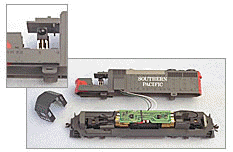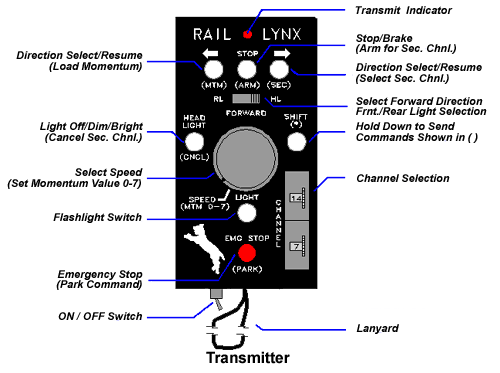|
|
|
|
RAIL-LYNXTM
INFRA RED DIGITAL COMMAND CONTROL SYSTEM |
 |
|
|
Infrared Direct Digital Control with State-of-the-Art Features |
 |
|
|
|
|
|
|
 |
Infra-Red data
transfer to locomotive |
|
|
|
|
 |
A microcomputer in every locomotive and hand held controller |
|
|
|
|
 |
255 different locomotive addresses |
|
|
|
|
 |
Multiple locomotive compatibility is standard |
|
|
|
|
 |
Locomotive addresses changeable from hand held controller |
|
|
|
|
 |
No command signals sent via track |
|
|
|
|
 |
True walk around control - no tether wire |
|
|
|
|
 |
Rotary knob and push button speed control |
|
|
|
|
 |
East - west push button direction control |
|
|
|
|
 |
Smooth speed ramp up - down |
|
|
|
|
 |
Emergency button stops EVERY train in area |
|
|
|
|
 |
Runs on any layout using existing power packs |
|
|
|
|
 |
Compatible with most command control systems |
|
|
|
|
 |
No "black boxes" to buy or install |
|
|
|
|
|
 |
|
Overview
|
| RAIL-LYNX Infrared
Digital Command Control is a revolutionary onboard
microprocessor-based train control system. Unlike systems which
require a tether wire from the control box to the layout, the
Rail-Lynx product is fully portable using direct communication from hand
held control to locomotive, providing complete control over all
locomotive functions. The hand held controller is compact and easy
to hold in one hand. Infrared technology allows complete data
transfer directly to the locomotives without any reliance on
track-fed signal. |
|
| Using 8 bit microcomputers
in the hand held controller and in each locomotive allows for full
and virtually step less control in both forward and reverse
direction for up to 255 locomotives. Each locomotive is programmed
by the hand held unit to accept its discrete control "code", and
from then on may be directly addressed by any operator. Actually,
each locomotive is capable of storing two addresses to which it will
respond, one primary and one secondary. The primary address is
normally loaded at the time of the receiver installation, although
it may be changed at any time from the hand held controller by
accessing a recessed switch. The secondary address is easily
changeable by means of two external thumb wheel switches on the
control unit, allowing for the same address to be assigned to
multiple locomotives for double heading (any number of locomotives
may be assigned to the same secondary address), even if one must be
commanded to run in reverse direction for back-to-back operation! A
speed offset can be programmed into the locomotives to allow for the
double headed locomotives to ramp up in speed at the same time. It
is possible to use more than one controller for the locomotive by
merely dialing in the same locomotive address code, allowing
hand-offs of control from one section of a layout to another if this
is desirable. Momentum can also be programmed into the locomotive to
simulate a loaded train. The receiver also has 4 output functions,
including off, dim, bright for front and rear headlights.
|
|
| The address code, speed
offset and momentum setting stored on-board each locomotive is
"non-volatile", meaning that it will be a part of the memory of the
locomotive until changed, even if power is removed and left off for
five years! Note that ALL changes are made through data sent from
the hand held unit, there is never a need to bring a locomotive to
the workbench for any change desired and no jumpers or other wiring
changes are ever required. Power for the hand held controller is
supplied by enclosed rechargeable lead acid battery or 4 AAA
batteries. |
|
| The RAIL-LYNX throttle
features rotary knob speed control and four pushbuttons to handle
all normal train functions. The "east" or "west" direction is
controlled by two push buttons. If the opposite direction button is
operated while the train is moving, the command will be ignored, as
a full stop is required before the direction can be changed. A stop
button is provided which, if operated with the train in motion, will
smoothly bring it to a stop. If either of the direction buttons is
then operated, the train will accelerate smoothly back up to the
previous set speed. Therefore switching operations may be performed
by simply using the E, W, and stop pushbuttons. Never will a train
abruptly change direction while at speed. In case of an imminent
"corn field meet" an emergency STOP button halts ALL trains in the
area, regardless of their address codes. A slide switch is provided
on the hand held unit to select the direction the "E" and "W"
pushbuttons will provide. The hand held unit also has a built in
flashlight, actually a super bright LED, to help see train numbers
and waybills in darkened layouts and a wrist lanyard to keep the
controller off the floor. |
|
 |
|
| A simple starter system
requires only a hand held controller and one locomotive receiver,
and upgrading the system at any time only requires additional
receivers and/or hand held units. No expensive "black boxes" or
external computers are required, as all the system requires to
operate is constant 12 to 16 volts D.C. from your existing power
pack. If you already have an older command control system, RAIL-LYNX
operates transparently and simultaneously with it. |
|
| The installation of the
RAIL-LYNX receiver in a locomotive is slightly more involved than
some older command receivers, but experienced modelers should have
no problems accomplishing this. The principal difference is in the
required installation of an infrared sensor somewhere on the upper
surface of a locomotive, coal tender or diesel "B" unit. The black
sensor has a small "bubble" on top to detect the incoming data and
only this part must protrude through the top of the body structure.
The receiver itself has the capacity to drive over an Ampere of
motor current, and the entire receiver and locomotive motor system
operates regardless of track polarity. |
|
| The RAIL-LYNX system stores
all current data in the microcomputer, onboard the locomotive, so
commands need only be sent when a change in status is called for.
Therefore, the train will continue running in a steady state without
a constant signal from the hand held controller. For track plans
that have tunnels or inaccessible staging yards, an inexpensive
repeater is available so the train will always have access to
current changes in commands. The possibility of interference does
exist when several of the controllers are being used simultaneously
in a confined area, but since the update transmission takes only 0.1
seconds, if one data transfer is missed the next one will almost
certainly be received. |
|
|
|